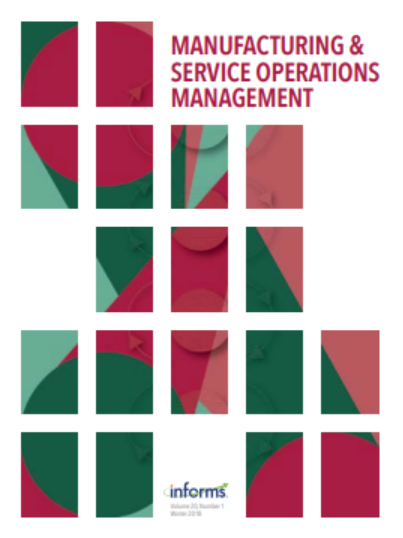通过分类优化提高约会市场的匹配率
IF 4.8
3区 管理学
Q1 MANAGEMENT
M&som-Manufacturing & Service Operations Management
Pub Date : 2023-07-01
DOI:10.1287/msom.2022.1107
引用次数: 1
摘要
问题定义:受我们与一家在线约会公司合作的启发,我们研究了一个平台应该如何动态地选择一组潜在的合作伙伴,在每个时期向每个用户展示,以便在一个时间范围内最大化预期的匹配数量,其中只有在两个用户彼此喜欢之后才会形成匹配,可能是在不同的时期。学术/实践相关性:提高匹配率是在线平台的普遍目标。我们提供了如何利用用户的偏好和行为来实现这一目标的见解。我们提出的算法由我们的合作者——美国一家主要的在线约会公司——试行。方法论:我们的工作结合了几种方法。我们将平台问题建模为一个动态优化问题。我们使用计量经济学工具并利用公司算法的变化来估计用户的偏好和先前匹配对用户类似行为的因果影响,以及其他感兴趣的参数。利用我们的数据发现,我们提出了一系列启发式方法来解决平台的问题,并使用模拟和现场实验来评估它们的好处。结果:我们发现最近获得的匹配数量对用户的喜欢行为有负面影响。我们提出了一系列启发式方法来决定每天向每个用户显示的配置文件,以解释这一发现。两个现场实验表明,与我们的行业合作伙伴的算法相比,我们的算法的匹配率至少高出27%。管理意义:我们的研究结果强调了正确计算交易两端用户的偏好、行为和活动指标的重要性,以提高匹配平台的运营效率。此外,我们提出了一种新的识别策略来衡量在双边匹配市场中以前的匹配对用户偏好的影响,我们的算法利用了这一结果。我们的方法也可以应用于其他领域的在线匹配平台。历史:本文已被接受为2021年制造业&服务营运管理实务研究比赛。补充材料:在线附录可在https://doi.org/10.1287/msom.2022.1107上获得。本文章由计算机程序翻译,如有差异,请以英文原文为准。
Improving Match Rates in Dating Markets Through Assortment Optimization
Problem definition: Motivated by our collaboration with an online dating company, we study how a platform should dynamically select the set of potential partners to show to each user in each period in order to maximize the expected number of matches in a time horizon, where a match is formed only after two users like each other, possibly in different periods. Academic/practical relevance: Increasing match rates is a prevalent objective of online platforms. We provide insights into how to leverage users’ preferences and behavior toward this end. Our proposed algorithm was piloted by our collaborator, a major online dating company in the United States. Methodology: Our work combines several methodologies. We model the platform’s problem as a dynamic optimization problem. We use econometric tools and exploit a change in the company’s algorithm in order to estimate the users’ preferences and the causal effect of previous matches on the like behavior of users, as well as other parameters of interest. Leveraging our data findings, we propose a family of heuristics to solve the platform’s problem and use simulations and field experiments to assess their benefits. Results: We find that the number of matches obtained in the recent past has a negative effect on the like behavior of users. We propose a family of heuristics to decide the profiles to show to each user on each day that accounts for this finding. Two field experiments show that our algorithm yields at least 27% more matches relative to our industry partner’s algorithm. Managerial implications: Our results highlight the importance of correctly accounting for the preferences, behavior, and activity metrics of users on both ends of a transaction to improve the operational efficiency of matching platforms. In addition, we propose a novel identification strategy to measure the effect of previous matches on the users’ preferences in a two-sided matching market, the result of which is leveraged by our algorithm. Our methodology may also be applied to online matching platforms in other domains. History: This paper has been accepted as part of the 2021 Manufacturing & Service Operations Management Practice-Based Research Competition. Supplemental Material: The online appendix is available at https://doi.org/10.1287/msom.2022.1107 .
求助全文
通过发布文献求助,成功后即可免费获取论文全文。
去求助
来源期刊

M&som-Manufacturing & Service Operations Management
管理科学-运筹学与管理科学
CiteScore
9.30
自引率
12.70%
发文量
184
审稿时长
12 months
期刊介绍:
M&SOM is the INFORMS journal for operations management. The purpose of the journal is to publish high-impact manuscripts that report relevant research on important problems in operations management (OM). The field of OM is the study of the innovative or traditional processes for the design, procurement, production, delivery, and recovery of goods and services. OM research entails the control, planning, design, and improvement of these processes. This research can be prescriptive, descriptive, or predictive; however, the intent of the research is ultimately to develop some form of enduring knowledge that can lead to more efficient or effective processes for the creation and delivery of goods and services.
M&SOM encourages a variety of methodological approaches to OM research; papers may be theoretical or empirical, analytical or computational, and may be based on a range of established research disciplines. M&SOM encourages contributions in OM across the full spectrum of decision making: strategic, tactical, and operational. Furthermore, the journal supports research that examines pertinent issues at the interfaces between OM and other functional areas.
 求助内容:
求助内容: 应助结果提醒方式:
应助结果提醒方式:


